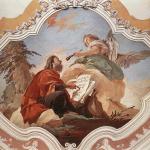4,000,000+ people on YouTube… and countless others across the world are reciting a verse in Church that no longer exists in their Bibles. And most likely, almost none of them are aware of it.
Once upon a time… actually, not so long ago, in a land… not so far away and probably closer than you think, someone was reading their Bible much like countless others have in times past.
And it happened that when they were reading those ancient words, that an idea or a verse stood out to them and influenced their lives and ministry. Hymns were written based on these verses and sometimes entire Churches took them on as doctrinal creeds.
However, there was one problem: the verses that they were quoting… though part of their own Bibles… haven’t remained in ours anymore.
In fact, to be more blunt, what was once scripture for them is now not even included in scripture for us. What was once holy writing for them is now for us non-canonical and apocryphal.
Yet, how did this happen? For most, it seems unthinkable. How can something be scripture for one generation (included in the Bible) and become something else for another?
For the sake of time, let’s look at 4 examples to discover the answer.
1. SOLOMON AND CHRISTMAS
In 1849, Edmund Sears wrote the classical Christmas hymn “It Came Upon the Midnight Clear.” It became a hugely popular hymn and is still widely sung and known across the world.
What many people have probably not stopped to ask themselves is why the song says that Jesus was born at midnight?
The truth is that the song is based on a verse from Sears’ Bible that is no longer in modern Protestant Bibles. In fact, it’s from an entire book that used to be in his Bible but is no longer included in modern Protestant Bibles!
The ancient work, titled “The Wisdom of Solomon,” is included today in all modern versions of the Old Testament in Catholic and Orthodox Bibles (which is another way of saying that the majority of Christians in the world today still consider it scripture), but in the last 120 or so years, was removed from Protestant Bible translations.
Sears (a Protestant), living in 1849, still had a Protestant Bible (the KJV) that included this book.
Why is this important? Because he read in Wisdom 18:14-16 that
“while all things were in quiet silence, and the night was in the midst of her swift course, thine Almighty Word leaped down from heaven out of thy royal throne.“
Although the author of Wisdom was speaking about the Exodus and the angel of death, he connected it with Jude 5 (see ESV) and the nativity in the gospels of Matthew and Luke.
And so it is, that each Christmas, Protestant Christians gather to sing a Christmas hymn that is based on a verse from a book that is no longer in their Bibles.
For the rest of the world’s Christians though, this doesn’t mean as much. After all, they still have the book and consider it scripture. So let’s look at another example that does affect all Christians and not simply my portion of the Church.
2. THE TRINITY AND KJV
If we turn to a contemporary example, we need look no further than singer Chris Tomlin and his famous contemporary hymn “How Great is Our God.” Released in 2004, it has had phenomenal success and become a staple new hymn for many church services.
I’ve sung (and performed) this song many times and it is a favorite of mine. Every line of the song is taken or inspired by a verse in scripture, making the song even more powerful for worship services. For a complete breakdown of the lyrics and where each line comes from, visit this website.
Yet, something about that website and its verse by verse breakdown is interesting. For the fourth stanza, there is no scriptural reference given for two lines in the song. Tomlin sings of
“The Godhead three in one. Father, Spirit, and Son.”
What gives? Why does it appear from the website that he quoted scripture everywhere but here? Well, in truth, he is quoting a verse (1 John 5:7). There we read that
“For there are three that bear record in heaven, the Father, the Word, and the Holy Ghost: and these three are one.“
There’s just one problem (and it’s the reason why the website didn’t include it): it’s not included in any Bibles anymore.
In reality, it was a forgery that a scribe added during the Medieval Ages and it was mistakenly added by the King James translators to their version.
So if you still have an old Bible, you can find the inspiration for Tomlin’s song, but if you have a modern Bible, you will find it as a tiny footnote at the bottom of the page, reminding you that some people still don’t realize it’s been removed.
What does that mean? 4,000,000+ people on YouTube are singing along with Tomlin and countless others across the world are reciting a verse in Church that no longer exists in their Bibles.
And most likely, almost none of them are aware of it. Maybe not even Tomlin.
3. ANGELS STIRRING WATER AND ART
More than just music was affected by such things though, so too was artwork.
Famous artists such as William Hogarth, Robert Bateman, Nicolas Poussin, Giovanni Domenico Tiepolo, Bartolome Esteban Murillo and Dirck van Delan to name a few, all set their paint to canvas because of the inspiration of the story of John 5:1-15 (otherwise called the Healing at the Pool of Bethesda).
What all of these artists have in common is that they had a Bible that included verse 4 which described that
“an angel went down at a certain season into the pool, and troubled the water: whosoever then first after the troubling of the water stepped in was made whole of whatsoever disease he had.“
In all of these famous artists’ depictions of the healing by Jesus, an angel is present. The strange thing for us reading today is that modern Bibles do not include this verse because it is now known to be a forgery that a later scribe added to the text.
Yet, that forgery fooled the King James translators who didn’t know any better and made it’s way into a very famous and influential English translation of the Bible and as such, influenced many artists who would have otherwise never thought an angel was present in the story.
As a result, many today have grown up seeing depictions of the story that include elements no longer included in their Bibles.
4. SHEPHERDS AND ANGELS
Aside from songs we sing and art we view, what about ideas we commonly believe?
Have you ever heard that story told to you when you were young about how you have a good angel on one side of you and a bad angel on another side (typically situated to your right and left respectively), and each is trying to sway you to do either something good or not, locked in a lifelong battle for your soul?
If you were never seriously taught the concept, you were probably exposed to it in many cartoons. What if I told you that the idea came from a verse that used to be in your Bible?
The Shepherd of Hermas is a book that was written a few decades after John wrote Revelation and was the last major Christian prophetic work written during the Early Church. According to the author, Hermas, a freed slave, the visions came to him from an angel who instructed him regarding the role of the church in the future to come.
More ethical instruction than apocalyptic vision, the book is one of the longest works of any biblical work, making Isaiah even seem shorter.
The work was extremely popular in early Christianity and was widely accepted as genuinely inspired, if not scripture, by all the Early Church initially.
Athanasius, an early Church father, although not affirming the work as scripture, did support (and stated that those before him had supported) the idea that when new Christians were baptized, they should read the Shepherd before reading the other works of the Bible in order to best understand the Christian message.
The very idea of imagining Jesus as a shepherd with a sheep wrapped around his arms became popular not because of the New Testament we have, but the Shepherd. Some early Christians in the 2nd century even drank from goblets that had engravings of the “Good Shepherd,” a reference to the vision of the book.
Of course, many Christians did not share the view of Athanasius that it was not scripture. Many, if not most, were convinced it was.
We have more copies preserved from antiquity in many cases of the Shepherd than we do of other Biblical books, which indicates that the work was treated as scripture by those who preserved it. We know that it was quoted as scripture and argued from during the Council of Nicaea and most interesting of all, the earliest complete Bible that we have preserved from the 4th century (Codex Siniaticus) includes it as the final book of the New Testament.
However, around the 5th – 6th century, the book’s popularity dwindled until it was gone and the result is that a book that some early Bible’s included as scripture and new converts read before anything else is now not included in any church as scripture.
Yet, the ideas from that book have remained. Shepherd of Hermas 36:1-4 presents the view, straight from the testimony of an angelic being, that all humans have two angels fighting over them, one good and one evil.
The book may have been removed from the Bible, but the teaching it gave clearly has remained with us thousands of years later.
CONCLUSION
While all of this is fascinating, it can also prove disturbing for some.
In the popular imagination, the Bible is supposed to be among other things: stable, unchanging and constant. Yet, these few examples (and many more that I did not mention) illustrate the fact that the Bible is anything but stable, unchanging and constant. It is a growing work that is influenced by the people who help to shape it.
This is why many ministers and scholars feel very uneasy when some Christians say (without understanding) “The Bible and the Bible Alone” or “God says it, so that settles it.”
Such slogans are easy to say, but they ignore the known history of our Bible and how it developed and will continue to. They ignore that the Bible a Protestant holds is not the same as a Catholic holds, nor is the Catholic’s Bible the same as the Orthodox church member’s.
They ignore that the Bible they hold today is not the same that Luther, who coined the term “Sola Scriptura,” knew.
Even today, there are a few certain verses that are still included in our modern Bibles that are suspected to be forgeries and are likely to be removed by translation committees from the Bibles of our great-grandchildren (for those curious, they are usually placed in visible [brackets] in modern Bibles).
What stories do we think that we know now that our future generations will scratch their heads and wonder, “where did they get that idea from?”
What songs will they sing from our generation that in the future will sound good theologically, but will not be found anymore in those words within their sacred text?
God alone knows.
In the end, we can learn from this that the Bible is much more than a static text. It lives and it breathes and with each new day, it reveals something new to us about what it actually is, rather than what we’ve been taught to believe it is.
And the best part? What it actually is, is far more interesting.
 Matthew J. Korpman is a minister-in-training, Young Adult novelist and published researcher in Biblical Studies. A graduating quadruple major at the H.M.S. Richards Divinity School, completing degrees in fields such as Religious Studies, Philosophy and Archaeology, he is an active member of the Seventh-day Adventist church whose research interests include everything from the Apocrypha to the Apocalypse.
Matthew J. Korpman is a minister-in-training, Young Adult novelist and published researcher in Biblical Studies. A graduating quadruple major at the H.M.S. Richards Divinity School, completing degrees in fields such as Religious Studies, Philosophy and Archaeology, he is an active member of the Seventh-day Adventist church whose research interests include everything from the Apocrypha to the Apocalypse.













